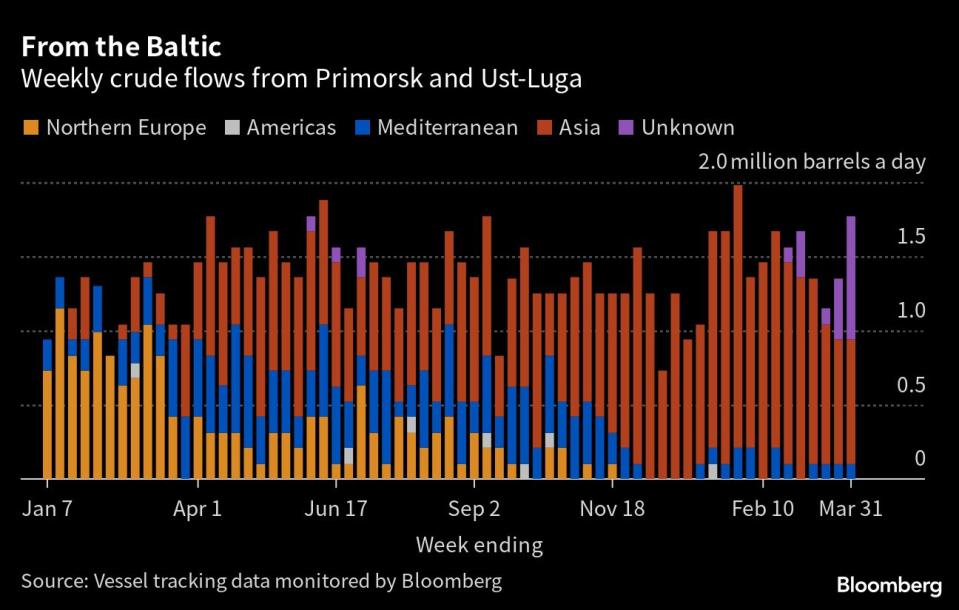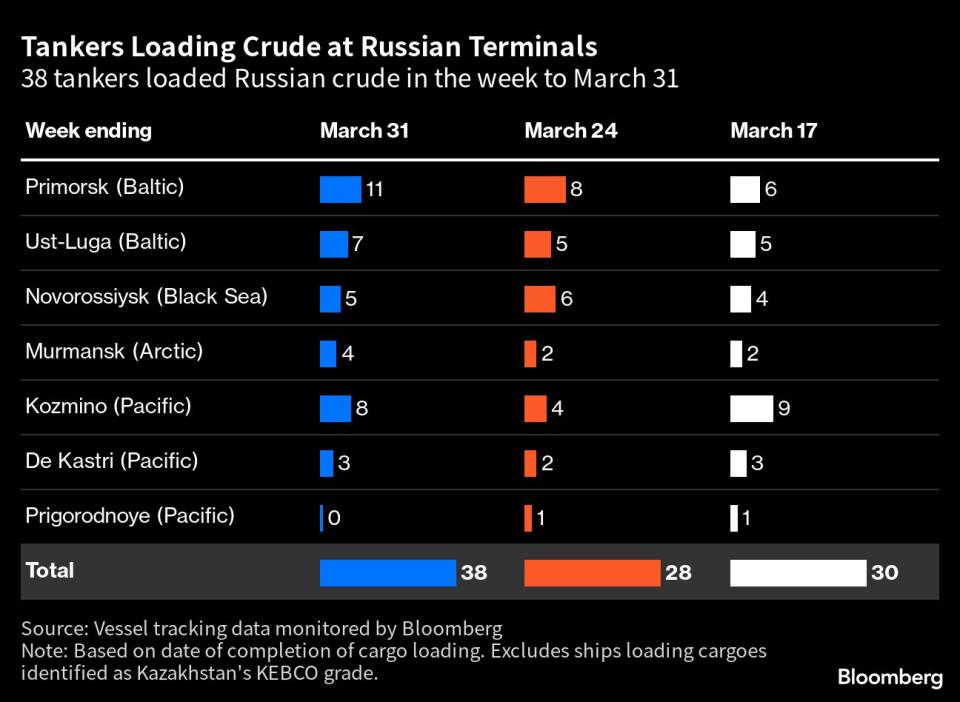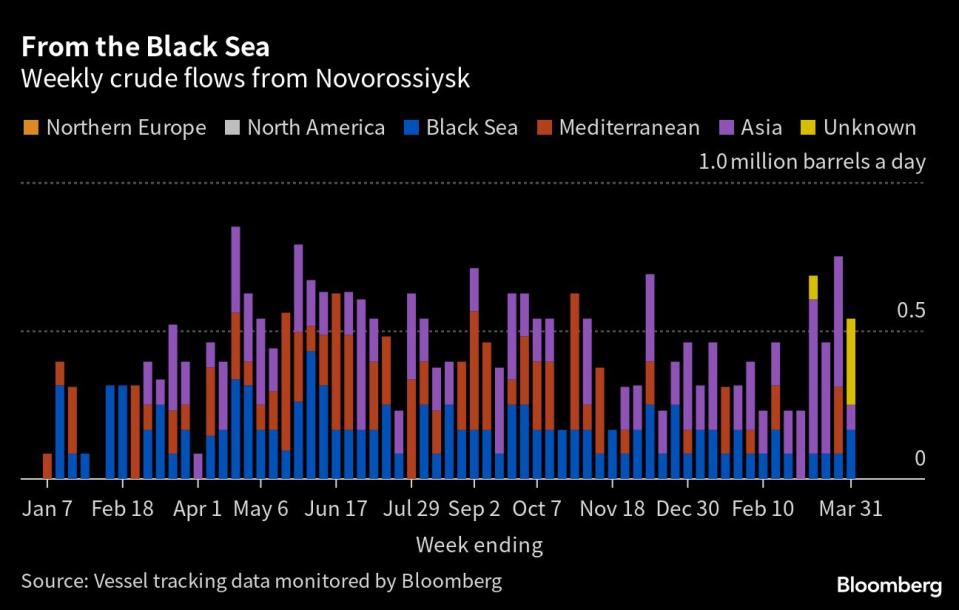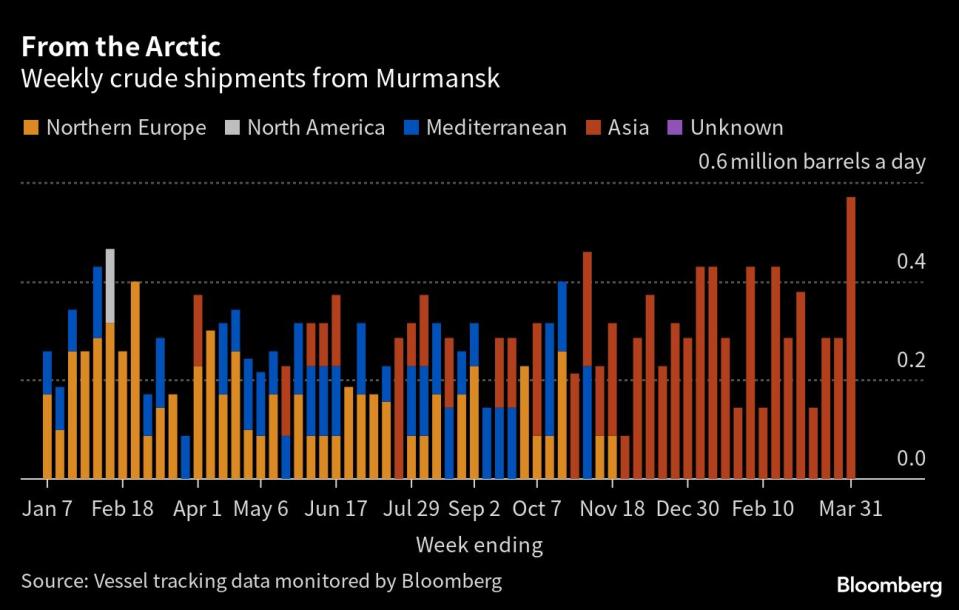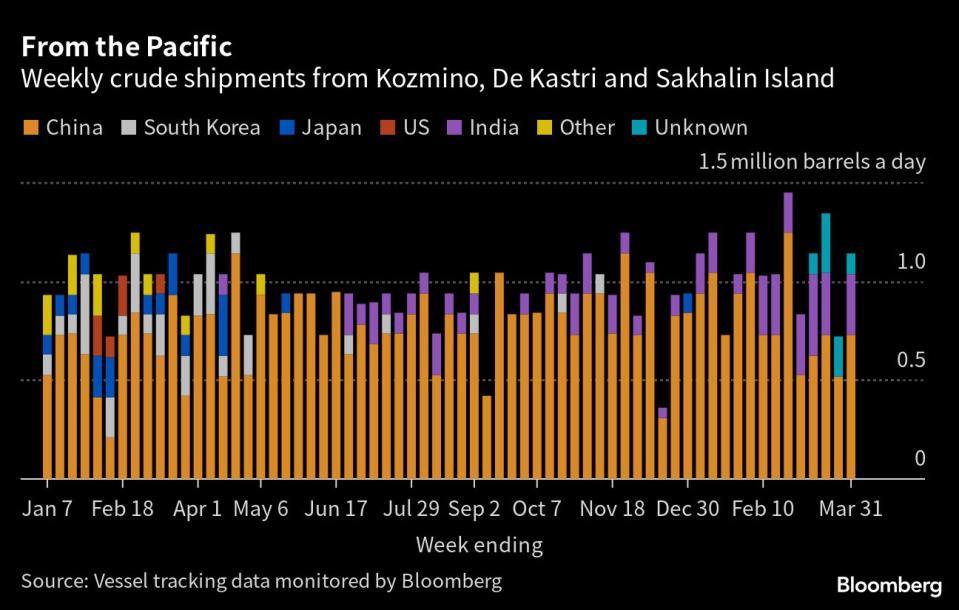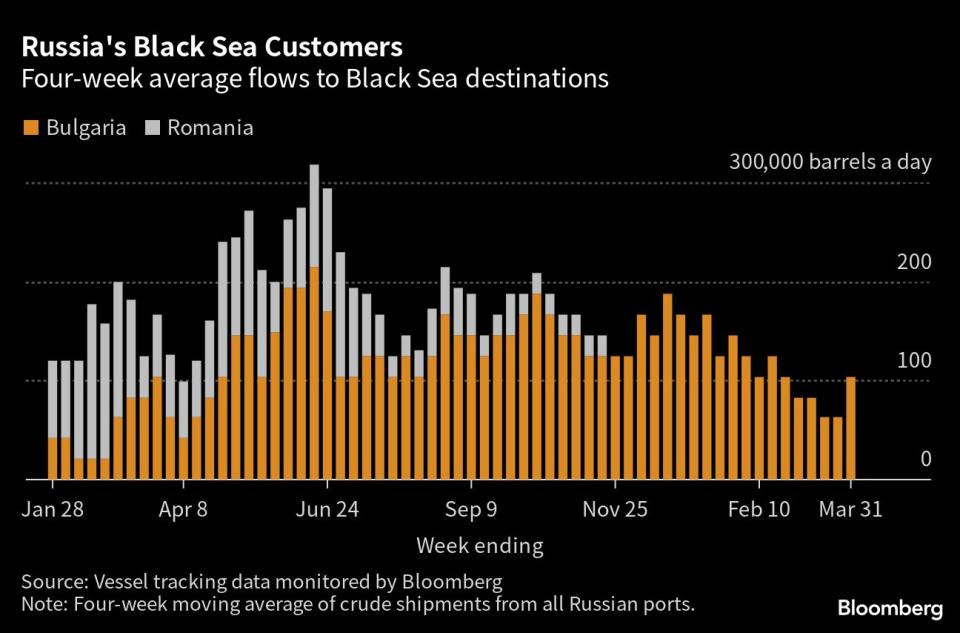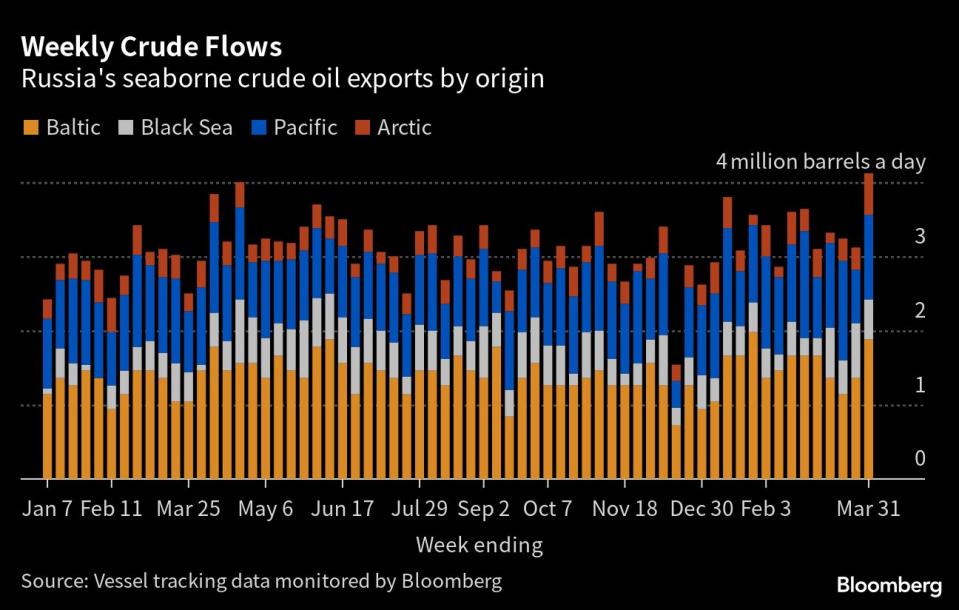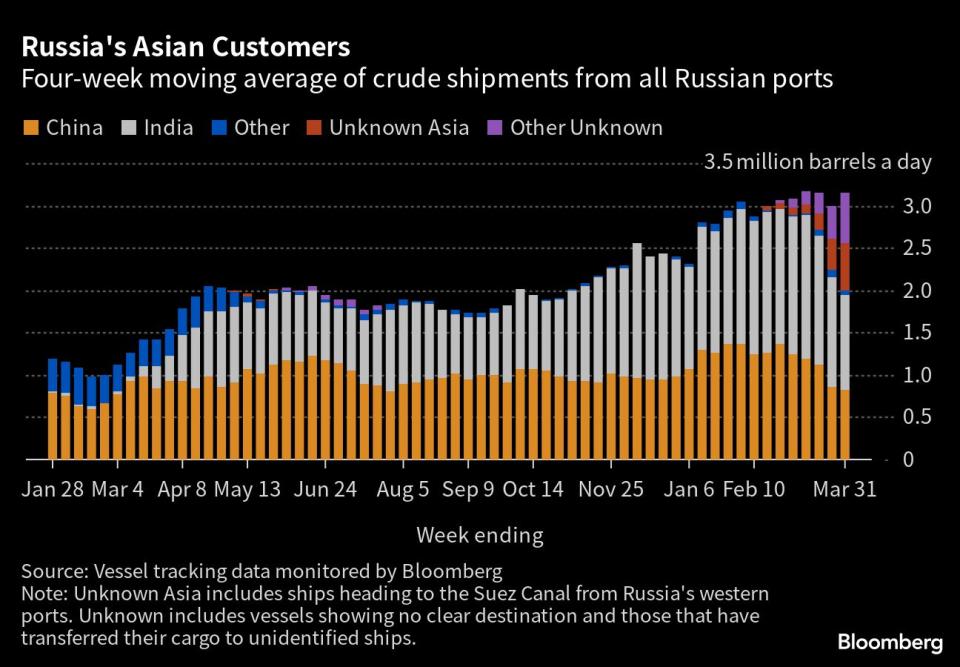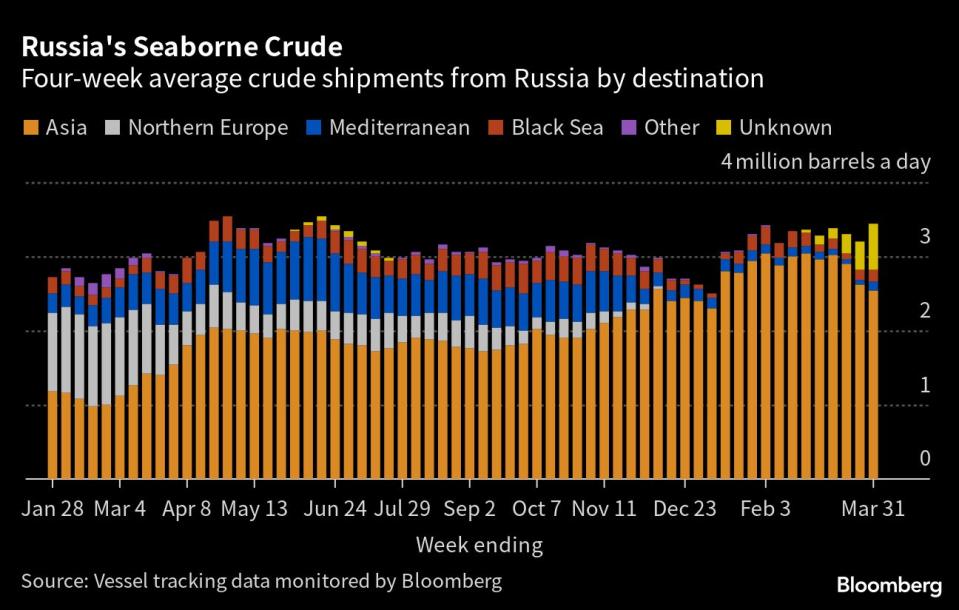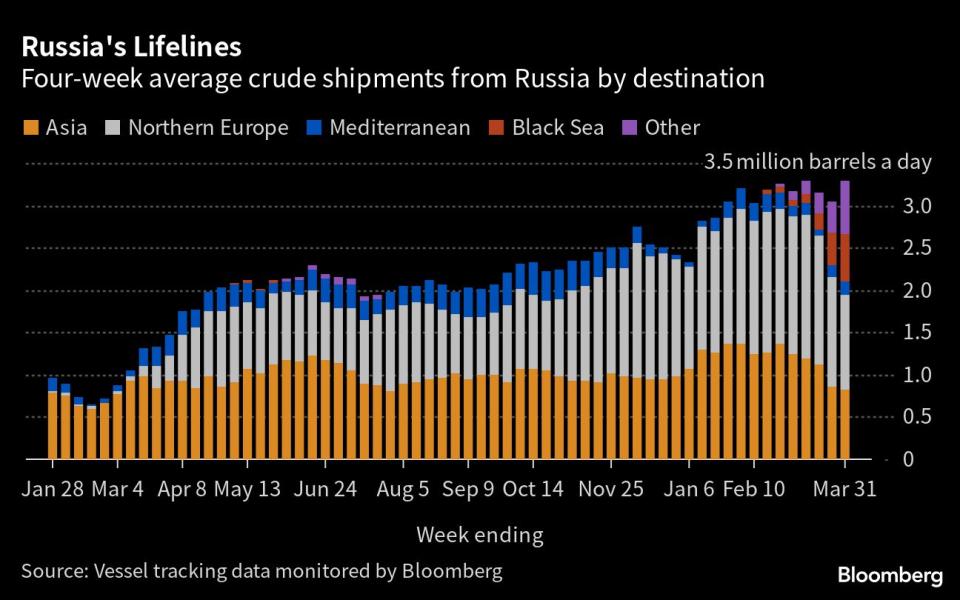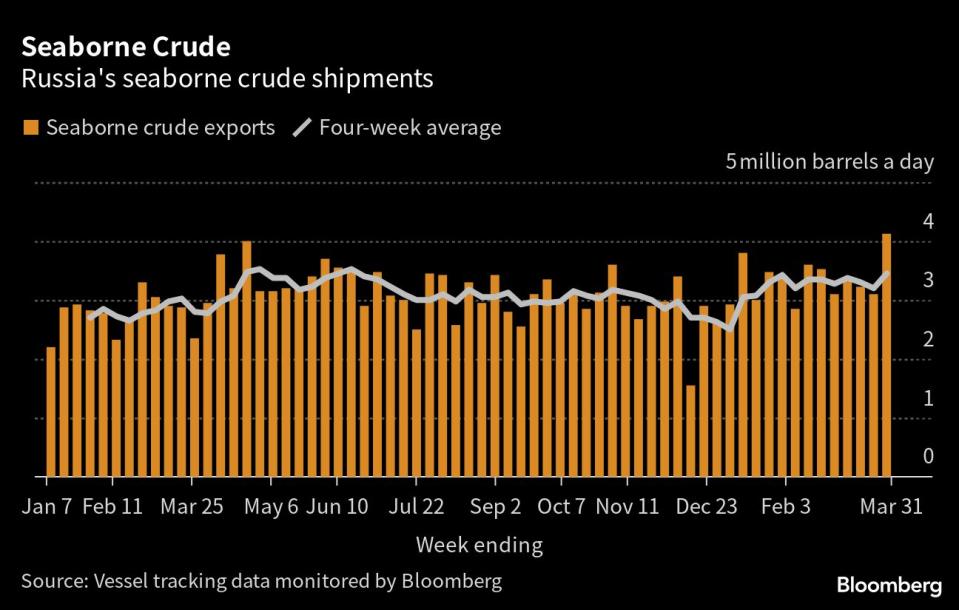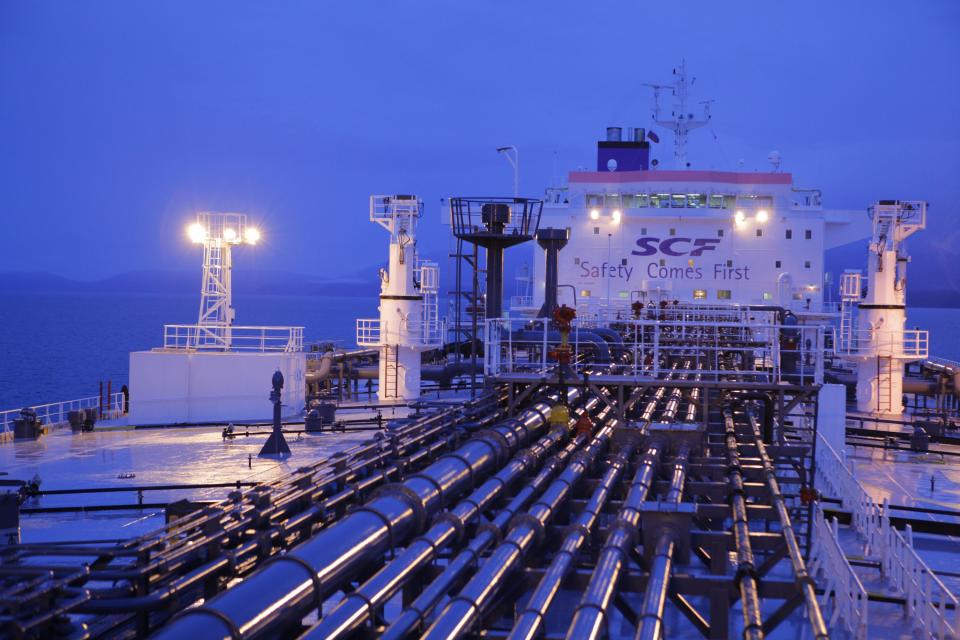Russia’s Oil Flows Surge to New High Despite Planned Output Cut
(Bloomberg) -- Russia’s seaborne crude flows are soaring, with no sign that the Kremlin’s threatened output cut is having any impact on the amount available on the international marketplace.
Most Read from Bloomberg
China’s Yuan Replaces Dollar as Most Traded Currency in Russia
A Kingdom Built on Oil Now Controls the World’s Climate Progress
The nation’s shipments surged by 1 million barrels a day to a new high of 4.13 million barrels a day in the seven days to March 31, according to tanker-tracking data compiled by Bloomberg. The less-volatile four-week average jumped to the highest since June.
Russia pledged to lower output by 500,000 barrels a day from last month through June in response to a Group of Seven price cap on the nation's crude sales. On Sunday, it extended the duration of the cut until the end of the year as part of a wider move by the OPEC+ producer group. There’s no evidence from the export figures that the initial cut has been implemented, raising questions about whether a real reduction will be made in the coming months.
Maintenance closures at Russia’s own refineries and the diversion to its ports of some crude volumes previously piped to Europe may have undermined the impact of any output reduction.
Separately, the price cap imposed on Moscow’s overseas crude sales will remain at $60 a barrel, with the mechanism seen as doing its job of keeping Russian crude flowing while hurting the Kremlin’s access to petrodollars. Russia still relies on Western insurers to cover more than half of the tanker fleet that exports its oil, according to data compiled by Bloomberg, suggesting that a large proportion of sales are being made below the cap.
The increase in seaborne flows seen at the start of the year, which is most apparent in the four-week average data, probably reflects the diversion of crude previously delivered to Poland and Germany through the Druzhba pipeline. Flows to Germany halted at the end of 2022 and deliveries to Poland dropped to about 60,000 barrels a day under the country’s last remaining supply contract with a Russian company.The loss of those pipeline markets means an additional 500,000 barrels a day of Russian crude is now being exported through the country’s ports, despite the European Union ban on imports of almost all of Moscow’s crude and refined fuels and the G7 price cap that together prompted Moscow’s threat to cut output.
The combined volume of crude on vessels heading to China and India plus smaller flows to Turkey and quantities on ships that haven’t yet shown a final destination jumped to a new high of 3.29 million barrels a day in the latest four-week period.
As the ultimate destinations of cargoes loading in late January became apparent, flows to China rose to new post-invasion highs, and remained close to those levels in February. Historical patterns suggest that most of the vessels currently identified as “Unknown Asia” destinations and heading for the Suez Canal will end up in India.
Ship-to-ship transfers of cargoes in the Mediterranean continue apace. This has been most visible off the Spanish north African city of Ceuta and off the Greek coast near Kalamata. At least 55 cargoes have been transferred between ships in those two locations since the start of the year. The volume transferred off the coast of Greece, mostly in the Bay of Lakonikos, fell back in March to 6.4 million barrels, equivalent to 208,000 barrels a day, from a revised 9.7 million barrels in February. That compares with 5.8 million barrels, equivalent to 188,000 barrels a day transferred off Ceuta.
A tanker carrying a cargo of Russian crude remains anchored off the Ghanaian port of Tema more than a month after it arrived at the west African country. The National Petroleum Authority granted a delivery period for the cargo to be unloaded, but national security considerations have held up the process, according to people familiar with the matter.
Crude Flows by Destination
Crude flows in the week to March 31 jumped by 1 million barrels a day from the previous week to a new high of 4.13 million barrels a day. On a four-week average basis, overall seaborne exports rose by 256,000 barrels a day to 3.45 million barrels a day.
All figures exclude cargoes identified as Kazakhstan’s KEBCO grade. Those are shipments made by KazTransoil JSC that transit Russia for export through the Baltic ports of Ust-Luga and Novorossiysk.
The Kazakh barrels are blended with crude of Russian origin to create a uniform export grade. Since Russia’s invasion of Ukraine, Kazakhstan has rebranded its cargoes to distinguish them from those shipped by Russian companies. Transit crude is specifically exempted from European Union sanctions.
Asia
Most Read from Bloomberg
Four-week average shipments to Russia’s Asian customers, plus those on vessels showing no final destination, rebounded above 3 million barrels a day after the previous week’s dip. Shipments rose to 3.16 million barrels a day in the period to March 31, compared with 2.99 million barrels a day previously.
While the volumes heading to China and India appear to have declined, history shows that most of the cargoes on ships without an initial destination eventually end up in one or other of those countries.
The equivalent of 555,000 barrels a day was on vessels showing destinations as either Port Said or Suez in Egypt, or which already have been or are expected to be transferred from one ship to another off the South Korean port of Yeosu. Those voyages typically end at ports in India or China and show up in the chart below as “Unknown Asia” until a final destination becomes apparent.
The “Other Unknown” volumes, running at 634,000 barrels a day in the four weeks to March 31, are those on tankers showing a destination of Ceuta, Kalamata or no destination at all. Most of those cargoes go on to transit the Suez Canal, but some could end up in Turkey. An increasing number are being transferred from one vessel to another in the Mediterranean for onward journeys to Asia.
Europe
Most Read from Bloomberg
Russia’s seaborne crude exports to European countries rose to 104,000 barrels a day in the 28 days to March 31, with Bulgaria the sole destination. These figures do not include shipments to Turkey.
A market that consumed more than 1.5 million barrels a day of short-haul crude, coming from export terminals in the Baltic, Black Sea and Arctic has been lost almost completely, to be replaced by long-haul destinations in Asia that are much more costly and time-consuming to serve.
No Russian crude was shipped to northern European countries in the four weeks to March 31.
Exports to Turkey, Russia’s only remaining Mediterranean customer, rose to a five-week high, averaging of 162,000 barrels a day in the four weeks to March 31.
Flows to Bulgaria, now Russia’s only Black Sea market for crude, rose to a five-week high of 104,000 barrels a day.
Flows by Export Location
Aggregate flows of Russian crude surged to a new high of 4.13 million barrels a day in the week to March 31. Jumps in exports from the Baltic, Pacific and Arctic was only partly offset by lower shipments from the Black Sea.
Figures exclude volumes from Ust-Luga and Novorossiysk identified as Kazakhstan’s KEBCO grade.
Export Revenue
Inflows to the Kremlin's war chest from its crude-export duty rose by $14 million to an 11-week high of $56 million in the seven days to March 31, while four-week average income rose by $4 million a seven-week high of $47 million.
President Vladimir Putin has signed into law amendments to the way Russia’s oil price is assessed for tax purposes. From April, rates of mineral extraction tax and profit-based tax on oil companies will be calculated using a decreasing discount to prevailing Brent prices, rather than assessments of Urals crude. Export duty, which will be phased out at the end of 2023, will not be affected by the change.
The duty rate for March was set at $1.94 a barrel, the first increase since December, based on a Urals price of $50.51 a barrel during the assessment period that ran from Jan. 15 to Feb. 14. April will remain virtually unchanged, with export duty on crude set at $1.95 a barrel. That’s based on an average Urals price of $50.80 a barrel, more than $34 below the average Brent price during the assessment period of Feb. 15 to March 14.
Origin-to-Location Flows
The following charts show the number of ships leaving each export terminal and the destinations of crude cargoes from the four export regions.
A total of 38 tankers loaded 28.9 million barrels of Russian crude in the week to March 31, vessel-tracking data and port agent reports show. That’s up by 7.1 million barrels, or 33%, from the previous week. Destinations are based on where vessels signal they are heading at the time of writing, and some will almost certainly change as voyages progress. All figures exclude cargoes identified as Kazakhstan’s KEBCO grade.
The total volume on ships loading Russian crude from Baltic terminals jumped to a nine-week high of 1.77 million barrels a day.
Shipments from Novorossiysk in the Black Sea fell back from the previous week’s multi-month high, with flows dropping to 540,000 barrels a day.
Arctic shipments soared to a new high, with four Suezmax tankers loading in the week to March 31.
Flows from the Pacific rebounded from their lowest in more than three months. Eleven tankers loaded at the region’s three export terminals in the week to March 31, up from seven the previous week.
India is continuing to take an significant volume of ESPO crude, accounting for nine out of 32 cargoes that loaded in March, compared with two out of a total 30 shipments in February.
The volumes heading to unknown destinations are all Sokol cargoes that have recently been transferred to other vessels at Yeosu, or are currently being shuttled to an area off the South Korean port from the loading terminal at De Kastri. Most of these are also ending up in India.
Note: This story forms part of a regular weekly series tracking shipments of crude from Russian export terminals and the export duty revenues earned from them by the Russian government.
Note: All figures exclude cargoes owned by Kazakhstan’s KazTransOil JSC, which transit Russia and are shipped from Novorossiysk and Ust-Luga as KEBCO grade crude.
Note: The next version of this story will be published on Tuesday April 11.
--With assistance from Sherry Su.
Most Read from Bloomberg Businessweek
Paris’s Air Taxi Stations Could Be Ready Before the Taxis Are
US and Europe Wrangle Over Green Subsidies to Avoid a Trade War
©2023 Bloomberg L.P.

